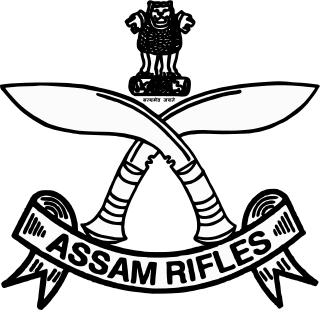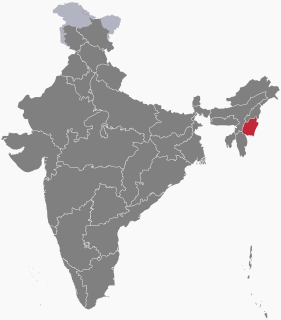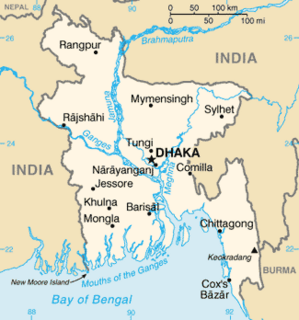Related Research Articles

The Border Security Force (BSF) is India's border guarding organisation on its border with Pakistan and Bangladesh. It is one of the seven Central Armed Police Forces (CAPF) of India, and was raised in the wake of the 1965 war on 1 December 1965, "for ensuring the security of the borders of India and for matters connected there with".

The Assam Rifles is the oldest branch of the Indian Army, dating back to 1835 under the British Raj, raised under the name Cachar Levy. The present name of "Assam Rifles" has been used since 1917. Similar to the Rashtriya Rifles in Jammu and Kashmir, in the Northeastern States the Assam Rifles is the specialised force that carries out anti-insurgency operations in difficult terrain of the region. Over the course of its history, the Assam Rifles have served in a number of roles, conflicts and theatres including World War I, where they served in Europe and the Middle East, and World War II, where they served mainly in Burma. After the Chinese annexation of Tibet, the Assam Rifles were tasked with manning the Tibetan border of Assam Himalayan region. They were also instrumental in maintaining law and order in Arunachal Pradesh.
Armed Forces Act (AFSPA), 1958 is an act of the Parliament of India that grants special powers to the Indian Armed Forces to maintain public order in "disturbed areas". According to the Disturbed Areas Act, 1976 once declared 'disturbed', the area has to maintain status quo for a minimum of 6 months. One such act passed on 11 September 1958 was applicable to the Naga Hills, then part of Assam. In the following decades it spread, one by one, to the other Seven Sister States in India's northeast. Another one passed in 1983 and applicable to Punjab and Chandigarh was withdrawn in 1997, roughly 14 years after it came to force. An act passed in 1990 was applied to Jammu and Kashmir and has been in force since.

Terrorism in India, according to the Home Ministry, poses a significant threat to the people of India. Compared to other countries, India faces a wide range of terror groups. Terrorism found in India includes Islamic terrorism, separatist terrorism, and left wing terrorism India is one of the countries most impacted by terrorism.

The Assam Regiment is an infantry regiment of the Indian Army. The regiment consists of 25 battalions: 15 regular battalions, 3 Rashtriya Rifles battalions, 5 Territorial Army battalions. It recruits exclusively from all the eight Northeastern states of India.

The 2001 Bangladesh–India border clashes were a series of armed skirmishes between India and Bangladesh in April 2001. The clashes took place between troops of the Bangladesh Rifles (BDR) and the Indian Border Security Force (BSF) on the poorly-marked international border between the two countries.
The Alkhan-Yurt massacre was the December 1999 incident in the village of Alkhan-Yurt near the Chechen capital Grozny involving Russian troops under command of General Vladimir Shamanov. The villagers claimed approximately 41 civilians were killed in the spree, while human rights groups confirmed and documented 17 incidents of murder and three incidents of rape.

In the 2008 Imphal bombings, at least 17 people were killed and more than 30 were injured on 21 October 2008.
The Bangladesh Rifles revolt was a mutiny staged on 25 and 26 February 2009 in Dhaka by a section of the Bangladesh Rifles (BDR), a paramilitary force mainly tasked with guarding the borders of Bangladesh. The rebelling BDR soldiers took over the BDR headquarters in Pilkhana, killing BDR director-general Shakil Ahmed along with 56 other army officers and 17 civilians. They also fired on civilians, held many of their officers and their families hostage, vandalised property and looted valuables. By the second day, unrest had spread to 12 other towns and cities. The mutiny ended as the mutineers surrendered their arms and released the hostages after a series of discussions and negotiations with the government.

The Mizo National Front uprising was a revolt against the government of India aimed at establishing a sovereign nation state for the Mizo people, which started on 28 February 1966. On 1 March 1966, the Mizo National Front (MNF) made a declaration of independence, after launching coordinated attacks on the Government offices and security forces post in different parts of the Mizo district in Assam. The government retaliated and recaptured all the places seized by the MNF by 25 March 1966.
Secession in India typically refers to state secession, which is the withdrawal of one or more states from the Republic of India. Whereas, some have wanted a separate state, union territory or an autonomous administrative division within India. Many separatist movements exist with thousands of members, however, some have low local support and high voter participation in democratic elections.

Human rights abuse is an ongoing insurgency in Manipur, a northeastern Indian state. The issue started in the 1960s due to a separatist conflict. Insurgent groups kidnapped children to train them as child soldiers against the Indian government. Manipur was declared a “disturbed area” by the Indian government in 1980 in the Armed Forces Special Powers Act of 1958.

Human rights abuses in Assam have been compared to the situation of human rights abuses in other insurgency-affected areas of northeast India.

Human rights issues in northeast India have been widely reported in the press and by human rights activists. Northeast India refers to the easternmost region of India consisting of the states of Arunachal Pradesh, Assam, Manipur, Meghalaya, Mizoram, Nagaland, Sikkim, and Tripura, as well as parts of northern West Bengal.
Thangjam Manorama (1970–2004) was a 32 year old woman from Manipur, India who was killed by the Indian paramilitary unit, 17th Assam Rifles on 11 July 2004. Her bullet-ridden and badly mutilated dead body was found abandoned three kilometers away from her home where she was arrested the earlier night. She was shot several times. Investigations revealed that she was tortured and raped before being killed but there was involvement of Assam Rifles.
Oinam Hill, also Onaeme village is a Poumai Naga village situated at some 40 km from Senapati district Headquarters and 20 km from NH-39/2 at Maram Town point and roughly 80 km from Kohima, Nagaland falling under Purul Sub-division in the present Manipur state. It is located in the heart of the Leopaona area surrounded by Thingba Khullen and Thingba Khunou in the West, Purul in the East, Khongdei and Ngamju in the north and the beautiful Barak River in the south. The village has rich forest land with varied flora and fauna. Onaeme village is located on a hillock with a sloping curve from north to south and east to west.

The Insurgency in Manipur is an ongoing armed conflict between India and a number of separatist rebel groups, taking place in the state of Manipur. The Insurgency in Manipur is part of the wider Insurgency in Northeast India; it combines elements of a national liberation war as well as an ethnic conflict.

Deaths along the Bangladesh–India border occur many times a year as result of people attempting to illegally cross into India from Bangladesh, cross border firing and cattle smuggling. Bangladesh and India share a 4,096 kilometer border. To prevent smuggling and illegal migration from Bangladesh, the Indian Border Security Force exercises its controversial "Shoot-on-sight" policy. Under this policy, the BSF can shoot any person on site with or without cause. A large portion of the victims are cattle traders and farmers with land near the border. Regarding border killings, Brad Adams, Executive Director of the Asia Department of Human Right Watch state that, "Routinely shooting poor, unarmed villagers is not how the world's largest democracy should behave."
This is a timeline of the Insurgency in Northeast India, an ongoing armed conflict between the separatist rebels and the Indian government.

The Matikhrü Massacre, took place on September 6, 1960, when forces of the 16th Punjab Regiment of the Indian Army committed an act of mass murder against the village of Matikhrü.
References
- 1 2 3 4 5 6 "Manipur : 5 things you should know about Operation Bluebird and its horror story". thenortheasttoday.com. 2018-10-07. Retrieved 2021-09-16.
- 1 2 3 4 Haksar, Nandita. "Manipur killings, 1987: Charges against Assam Rifles disposed of – though evidence has gone missing". Scroll.in. Retrieved 2021-09-17.
- 1 2 "Manipur's horror: When Operation Bluebird struck terror". Hindustan Times. 2014-11-05. Retrieved 2021-09-22.